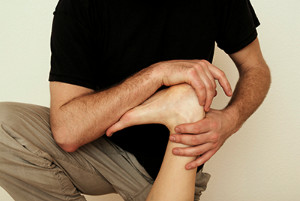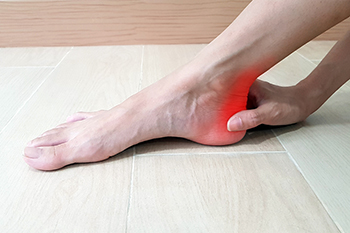Bremerton | Port Orchard (360) 377-2233

One of the most important components of your foot is the big toe joint, scientifically known as the first metatarsophalangeal joint, or first MPJ. When issues arise within this joint, they can significantly impact your daily life, ranging from walking to overall body posture. Hallux limitus is a condition that pertains to the limited range of motion in the big toe joint. One of the main causes of this condition is inflammatory arthritis. Your big toe joint plays a critical role in walking and maintaining proper balance. When this joint loses its range of motion it can lead to significant difficulties in walking and cause pain during each step. This can alter the gait and in turn affect the knee, hip, and back. If arthritis is a contributing factor, disease specific medications can be prescribed. In severe cases, surgical intervention may be needed. Procedures can range from cleaning out the joint to more advanced surgeries, such as joint fusion or joint replacement. For an accurate appraisal of the problems involving your big toe pain, it is suggested that you make an appointment with a podiatrist.
Toe pain can disrupt your daily activities. If you have any concerns, contact one of our doctors of Kitsap Foot & Ankle Clinic. Our doctors can provide the care you need to keep you pain-free and on your feet.
What Causes Toe Pain?
Most severe toe pain is caused due to a sports injury, trauma from dropping something heavy on the toe, or bumping into something rigid. Other problems can develop over time for various reasons.
Toe pain can be caused by one or more ailments. The most common include:
When to See a Podiatrist
Diagnosis
In many cases the cause of toe pain is obvious, but in others, a podiatrist may want to use more advanced methods to determine the problem. These can range from simple visual inspections and sensation tests to X-rays and MRI scans. Prior medical history, family medical history, and any recent physical traumatic events will all be taken into consideration for a proper diagnosis.
Treatment
Treatments for toe pain and injuries vary and may include shoe inserts, padding, taping, medicines, injections, and in some cases, surgery. If you believe that you have broken a toe, please see a podiatrist as soon as possible.
If you have any questions please feel free to contact one of our offices located in Bremerton and Port Orchard, WA . We offer the newest diagnostic tools and technology to treat your foot and ankle needs.

Stretching is a vital practice for maintaining the health and flexibility of your feet and overall body. Regular stretching helps keep muscles flexible and strong, which is essential for preserving joint mobility. When muscles become tight and inflexible, it can lead to reduced range of motion, making daily activities challenging and increasing the risk of joint pain, strains, and muscle damage. For instance, sitting for prolonged periods can result in tight hamstrings, hindering leg extension and walking. When suddenly stretched during activities like sports, tight muscles may become injured, compromising joint support, and potentially causing joint injuries. Regular stretching also aids in balance, reducing the risk of falls, especially for individuals with balance issues. If you would like to learn specific exercises to do in your daily routine, it is suggested that you schedule an appointment with a podiatrist who can provide expert advice and take care of any feet or ankle issues that arise.
Why Stretching Is Important for Your Feet
Stretching the feet is a great way to prevent injuries. If you have any concerns with your feet consult with one of our doctors from Kitsap Foot & Ankle Clinic. Our doctors will assess your condition and provide you with quality foot and ankle treatment.
Stretching the Feet
Stretching the muscles in the foot is an important part in any physical activity. Feet that are tight can lead to less flexibility and make you more prone to injury. One of the most common forms of foot pain, plantar fasciitis, can be stretched out to help ease the pain. Stretching can not only ease pain from plantar fasciitis but also prevent it as well. However, it is important to see a podiatrist first to determine if stretching is right for you. Podiatrists can also recommend other ways to stretch your feet. Once you know whether stretching is right for you, here are some excellent stretches you can do.
It is best to go easy when first stretching your foot and work your way up. If your foot starts hurting, stop exercising to ice and rest the foot. It is advised that you then see a podiatrist for help.
If you have any questions, please feel free to contact one of our offices located in Bremerton and Port Orchard, WA . We offer the newest diagnostic and treatment technologies for all your foot care needs.

Achilles tendon injuries can cast a shadow over the start of the day, with many individuals experiencing heightened discomfort in the morning. This specific pain is often a result of the tendon's response to a period of inactivity during sleep. As the body rests, the tendon may tighten, and upon resuming activity, the sudden stretching can induce pain and stiffness. This morning agony is a common symptom in conditions such as Achilles tendonitis or tendinosis, where the tendon undergoes repetitive stress or degeneration. It is essential to recognize the significance of a gradual warm-up routine before stepping out of bed, incorporating gentle stretches to prepare the Achilles tendon for the day ahead. Additionally, wearing supportive footwear and avoiding sudden, high-impact activities in the morning can contribute to managing and minimizing the discomfort associated with Achilles tendon injuries during those initial awakening moments. If you have endured this type of injury, it is suggested that you are under the care of a podiatrist who can guide you toward effective treatment and relief techniques.
Achilles tendon injuries need immediate attention to avoid future complications. If you have any concerns, contact one of our doctors of Kitsap Foot & Ankle Clinic. Our doctors can provide the care you need to keep you pain-free and on your feet.
What Is the Achilles Tendon?
The Achilles tendon is a tendon that connects the lower leg muscles and calf to the heel of the foot. It is the strongest tendon in the human body and is essential for making movement possible. Because this tendon is such an integral part of the body, any injuries to it can create immense difficulties and should immediately be presented to a doctor.
What Are the Symptoms of an Achilles Tendon Injury?
There are various types of injuries that can affect the Achilles tendon. The two most common injuries are Achilles tendinitis and ruptures of the tendon.
Achilles Tendinitis Symptoms
Rupture Symptoms
Treatment and Prevention
Achilles tendon injuries are diagnosed by a thorough physical evaluation, which can include an MRI. Treatment involves rest, physical therapy, and in some cases, surgery. However, various preventative measures can be taken to avoid these injuries, such as:
If you have any questions please feel free to contact one of our offices located in Bremerton and Port Orchard, WA . We offer the newest diagnostic tools and technology to treat your foot and ankle needs.

A metatarsal fracture, a common injury affecting the long bones in the foot, occurs when one or more of these slender bones break due to excessive force or trauma. The metatarsals, positioned between the ankle and toes, play an important role in weight-bearing and overall foot function. The fracture can result from various incidents, including falls, direct impact, or sudden twisting motions. High-impact sports or accidents involving heavy objects may contribute to metatarsal fractures. The symptoms typically include pain, swelling, and difficulty bearing weight on the affected foot. Accurate diagnosis through imaging, such as X-rays, is essential for determining the extent of the fracture and guiding appropriate treatment. Understanding the nature of metatarsal fractures is pivotal for prompt medical attention and effective recovery. If you have endured a broken foot, it is suggested that you consult a podiatrist who can diagnose and offer treatment methods that are right for you.
A broken foot requires immediate medical attention and treatment. If you need your feet checked, contact one of our doctors from Kitsap Foot & Ankle Clinic. Our doctors can provide the care you need to keep you pain-free and on your feet.
Broken Foot Causes, Symptoms, and Treatment
A broken foot is caused by one of the bones in the foot typically breaking when bended, crushed, or stretched beyond its natural capabilities. Usually the location of the fracture indicates how the break occurred, whether it was through an object, fall, or any other type of injury.
Common Symptoms of Broken Feet:
Those that suspect they have a broken foot shoot seek urgent medical attention where a medical professional could diagnose the severity.
Treatment for broken bones varies depending on the cause, severity and location. Some will require the use of splints, casts or crutches while others could even involve surgery to repair the broken bones. Personal care includes the use of ice and keeping the foot stabilized and elevated.
If you have any questions please feel free to contact one of our offices located in Bremerton and Port Orchard, WA . We offer the newest diagnostic and treatment technologies for all your foot and ankle needs.